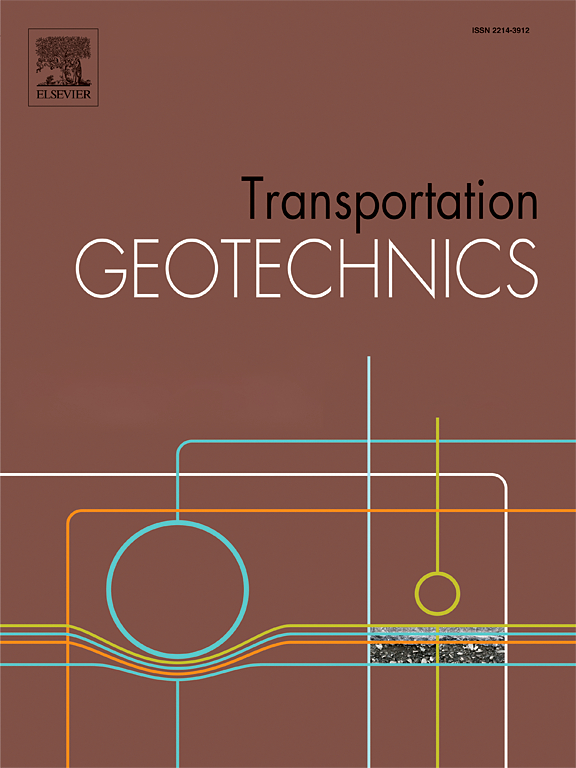Resilience assessment of the seismic damage mechanism of the Daliang high-speed railway tunnel in the 2022 Menyuan earthquake (Mw 6.7) in China
IF 4.9
2区 工程技术
Q1 ENGINEERING, CIVIL
引用次数: 0
Abstract
Intense fault dislocation within active fault zones can significantly impact the integrity of fault-crossing underground structures. This research examines the Daliang tunnel on the Lanzhou to Urumqi High-Speed Railway, which was severely damaged by the Menyuan great earthquake (Mw 6.7) in Qinghai Province, China, on January 8, 2022. The background of the earthquake and basic design information of Daliang high-speed railway tunnel is introduced. Field investigations demonstrate the seismic-induced damage, caused by the left-lateral strike-slip fault, can be categorized into five levels: extremely severe, severe, moderate, slight, and basically intact, which helps establish clear identification segments. A detailed analysis of damage mechanisms is conducted for each severity level, revealing that sections near the seismogenic fault experienced significant seismic damage, including pronounced uplift deformation of the roadbed slab, torsional fracture of the lining structure, alignment deformation, and extensive lining detachment, due to the combined effects of transient dislocation and the release of strong seismic motions from seismogenic fault. Other affected sections, affected by seismic vibrations and multiple contributing factors, exhibited varying degrees of damage, such as bottom bulging, fragmentation of the lining inner surface, multi-directional crack propagation, and localized peeling, as well as less discernible distribution patterns. Based on seismic damage classification, zoning, and detailed analysis of seismic damage mechanisms, this study proposes eight seismic resilience evaluation indicators for assessing the seismic damage of fault-crossing high-speed railway tunnels. These indicators include the cross-section area invasion rate, cross-section CPⅢ offset, and cross-section hundred-meter axial displacement rate, among others. A new quantitative standard for seismic resilience specific to fault-crossing high-speed railway tunnels is developed. The application of fuzzy set theory and fuzzy logic in evaluating the seismic resilience capabilities of fault-crossing high-speed railway tunnels is investigated. A resilience evaluation framework for assessing the seismic resilience of fault-crossing high-speed railway tunnels is established. Quantitative comprehensive assessments are conducted on 38 selected seismic damage sections to identify the extent of damage. The results validate the rationality and effectiveness of the proposed performance evaluation system for assessing seismic damage in fault-crossing high-speed railway tunnels. This research provides important references for the post-earthquake structural resilience performance recovery, structural safety assessment, and development of methodologies related to the seismic resilience of fault-crossing high-speed railway tunnels.
中国 2022 年门源地震(Mw 6.7)大梁高速铁路隧道震害机理复原评估
活动断层带内强烈的断层错动会严重影响穿越断层的地下结构的完整性。本研究考察了 2022 年 1 月 8 日在中国青海省门源大地震(Mw 6.7)中严重受损的兰州至乌鲁木齐高速铁路大梁隧道。本文介绍了大梁高速铁路隧道的地震背景和基本设计信息。现场调查表明,左侧走向滑动断层引起的震害可分为极重度、重度、中度、轻度和基本完好五个等级,有助于建立明确的识别区段。对每个严重等级的破坏机制进行了详细分析,结果表明,在地震断层附近的路段,由于瞬时错位和地震断层释放的强烈地震运动的共同作用,发生了严重的地震破坏,包括路基板明显的隆起变形、衬砌结构扭转断裂、线形变形和衬砌大面积脱落。其他受影响地段受地震振动和多种因素的影响,表现出不同程度的破坏,如底部隆起、衬里内表面破碎、多方向裂纹扩展和局部剥离,以及不明显的分布模式。在震害分类、分区和震害机理详细分析的基础上,本研究提出了八项抗震能力评价指标,用于评估断层穿越高速铁路隧道的震害。这些指标包括断面面积侵限率、断面CPⅢ偏移量、断面百米轴向位移率等。制定了穿越断层高速铁路隧道抗震能力的新定量标准。研究了模糊集理论和模糊逻辑在评估断层穿越高速铁路隧道抗震能力中的应用。建立了穿越断层高速铁路隧道抗震能力评估框架。对选定的 38 个震害地段进行了定量综合评估,以确定震害程度。结果验证了所提出的穿越断层高速铁路隧道震害评估性能评价体系的合理性和有效性。该研究为地震后高速铁路隧道结构抗震性能恢复、结构安全评估以及断层穿越高速铁路隧道抗震相关方法的开发提供了重要参考。
本文章由计算机程序翻译,如有差异,请以英文原文为准。
求助全文
约1分钟内获得全文
求助全文
来源期刊

Transportation Geotechnics
Social Sciences-Transportation
CiteScore
8.10
自引率
11.30%
发文量
194
审稿时长
51 days
期刊介绍:
Transportation Geotechnics is a journal dedicated to publishing high-quality, theoretical, and applied papers that cover all facets of geotechnics for transportation infrastructure such as roads, highways, railways, underground railways, airfields, and waterways. The journal places a special emphasis on case studies that present original work relevant to the sustainable construction of transportation infrastructure. The scope of topics it addresses includes the geotechnical properties of geomaterials for sustainable and rational design and construction, the behavior of compacted and stabilized geomaterials, the use of geosynthetics and reinforcement in constructed layers and interlayers, ground improvement and slope stability for transportation infrastructures, compaction technology and management, maintenance technology, the impact of climate, embankments for highways and high-speed trains, transition zones, dredging, underwater geotechnics for infrastructure purposes, and the modeling of multi-layered structures and supporting ground under dynamic and repeated loads.
 求助内容:
求助内容: 应助结果提醒方式:
应助结果提醒方式:


